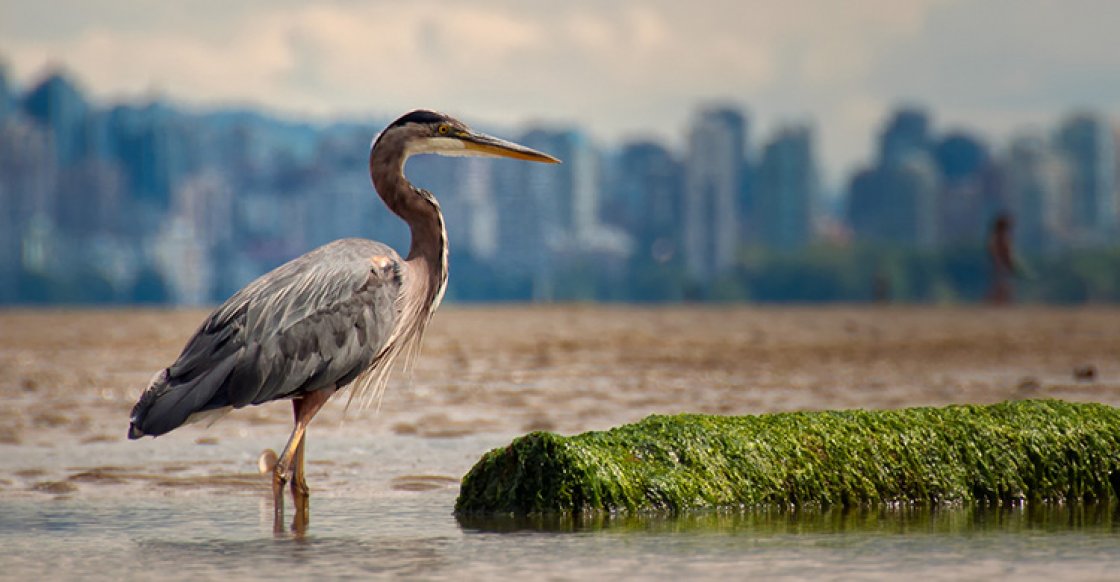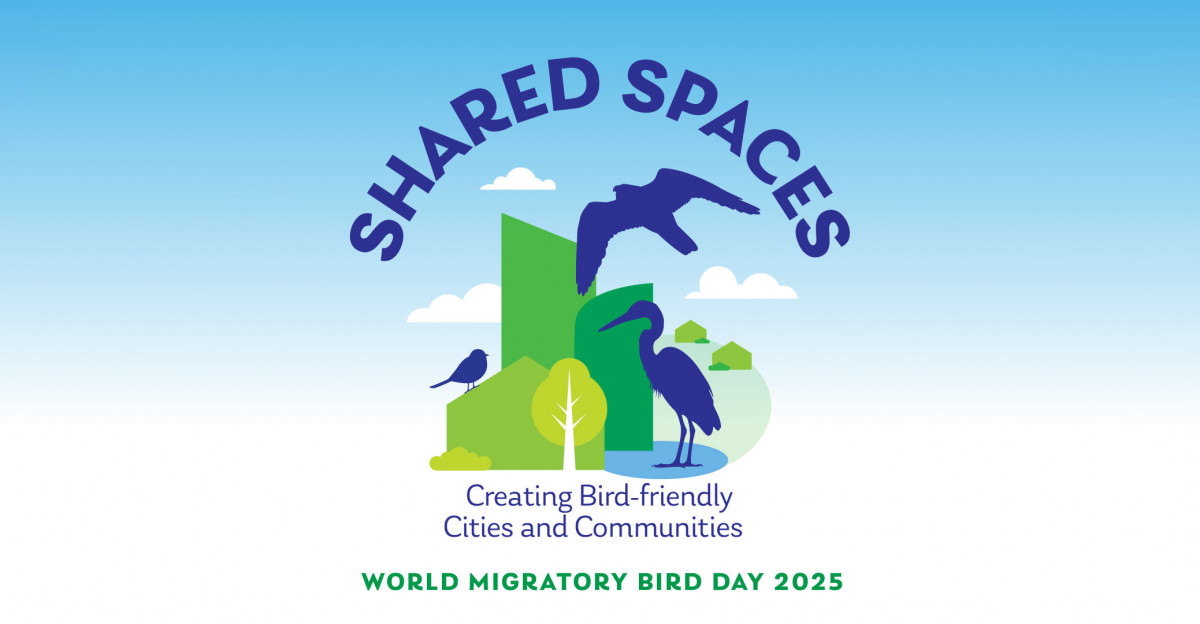You are here
World Migratory Bird Day Unveils 2025 Conservation Theme: Creating Bird-Friendly Cities & Communities

BONN/BOULDER/INCHEON, 14 November 2024 - The partners behind World Migratory Bird Day are happy to announce that the theme for the 2025 campaign will be dedicated to creating bird-friendly cities and communities. Next year's campaign will highlight the need for a healthy coexistence between humans and birds. It will focus on creating and adapting environments that support migratory bird populations across all communities, from bustling cities to smaller towns and communities. There are actions everyone can take to protect our shared spaces with wildlife.
In 2025, WMBD will raise awareness about the many challenges migratory birds face due to human activities and expanding urban development. The campaign will advocate for strategic urban planning and conservation efforts that incorporate bird-friendly practices, making sure that our communities become havens for these remarkable travelers. The 2025 theme encourages action from all sectors, including national and local governments, businesses, community groups, and individuals worldwide.
Key Messages and Conservation Efforts
WMBD 2025 will emphasize that every community - urban to rural - can play a significant role in supporting migratory birds. Through good city planning, and by adopting bird-friendly practices like creating healthy habitats, reducing pollution, and preventing collisions with glass windows and other built objects, communities can significantly contribute to the well-being of migratory birds.
Urban expansion and man-made environments, if not managed properly, pose significant threats to these birds, leading to habitat loss and increasing the risks like fatal collisions with buildings and glass. Through good upstream planning for sustainable urban development that avoids sprawl and destruction of habitat as well as collaborative efforts with neighbors, schools, and local organizations, everyone can protect birds and raise awareness about their importance to the health of the planet and its ecosystems. By bringing nature back into our cities and working together, citizens and elected officials alike can help our natural environments and lessen the negative effects of urbanization on biodiversity.

The two peak days of World Migratory Bird Day 2025 will be 10 May 2025 and 11 October 2025, reflecting the cyclical nature of bird migration with varying migration periods in the northern and southern hemispheres. For more information please visit: www.worldmigratorybirdday.org
About World Migratory Bird Day
World Migratory Bird Day is a global campaign that serves as a beacon for conservation efforts aimed at protecting migratory birds and their journeys across borders. Celebrated twice a year—in May and October—WMBD reflects the cyclical nature of bird migration and the varying peak periods in the northern and southern hemispheres. This worldwide initiative triggers countless educational events, uniting people in a common goal to protect migratory birds and their habitats.
Each year, WMBD selects a central theme to inspire action and concentrate global efforts towards preserving the habitats and wellbeing of migratory birds. The 2025 theme underscores the urgent need for bird-friendly cities, combining scientific insights with practical steps for individuals and communities to support these remarkable creatures.
The WMBD campaign is organized by the Convention on the Conservation of Migratory Species of Wild Animals (CMS), the African-Eurasian Migratory Waterbird Agreement (AEWA), Environment for the Americas (EFTA), and the East Asian-Australasian Flyway Partnership (EAAFP).
Join us in celebrating World Migratory Bird Day and take part in this global movement to create a brighter future for migratory birds and our shared natural world.
For more information about World Migratory Bird Day and ways to get involved, please visit www.migratorybirdday.org
About the Convention on Migratory Species (CMS)
An environmental treaty of the United Nations, the Convention on the Conservation of Migratory Species of Wild Animals (CMS) provides a global platform for the conservation and sustainable use of migratory animals and their habitats. This unique treaty brings governments and wildlife experts together to address the conservation needs of terrestrial, aquatic, and avian migratory species and their habitats around the world. Since the Convention's entry into force in 1979, its membership has grown to include 133 Parties from Africa, Central and South America, Asia, Europe and Oceania.
Learn more at www.cms.int
About the Agreement on the Conservation of African-Eurasian Migratory Waterbirds (AEWA)
The Agreement on the Conservation of African-Eurasian Migratory Waterbirds (AEWA) is an inter-governmental treaty dedicated to the conservation of migratory waterbirds that migrate along the African-Eurasian Flyway. The Agreement covers 255 species of birds ecologically dependent on wetlands for at least part of their annual cycle. A total of 84 countries and the European Union have signed the environmental treaty, which has a geographic range covering 119 countries across Africa, Europe, the Middle East, Central Asia, Greenland, and the Canadian Archipelago.
Learn more at www.unep-aewa.org
About Environment for the Americas (EFTA)
Environment for the Americas connects people to nature and birds through research, education, and outreach. At the heart of our efforts lies the coordination of World Migratory Bird Day across the Americas, an initiative that engages people of all ages in the protection of our shared migratory birds. This work has also led to the development of our internship programs, which provide unique opportunities for the next generation of researchers, conservationists, and natural resource professionals. Through these programs, we are empowering young people to make a tangible difference for the environment. EFTA’s efforts have also spurred international collaborations for bird conservation and facilitated changes across borders that ensure a future where migratory birds are protected and celebrated.
Learn more at www.environmentamericas.org
About the East Asian-Australasian Flyway Partnership (EAAFP)
The EAAFP is an international Partnership established in 2006 to provide a framework to promote dialogue, cooperation, and collaboration to conserve migratory waterbirds and their habitats in the East Asian–Australasian Flyway. It is also a Ramsar Regional Initiative. A unique element of the Partnership is its mission to build a chain of internationally important sites for these birds as they migrate across the 22 countries of the Flyway. These countries have the greatest species density on earth yet have the highest number of vulnerable migratory birds. Our 40 Partners work together across borders to make a difference for them.For more information, visit www.eaaflyway.net
For more information please contact:
Florian Keil, Information Officer / Coordinator of the World Migratory Bird Day Campaign at the CMS and AEWA Secretariats, Tel: +49 (0) 228 8152451, [email protected]
Susan Bonfield, Executive Director at Environment for the Americas, Tel: +001 970-393-1183, [email protected]
Minjae Baek, Communications Officer at the East Asian-Australasian Partnership, Tel: +82 32 458 6504, [email protected]
